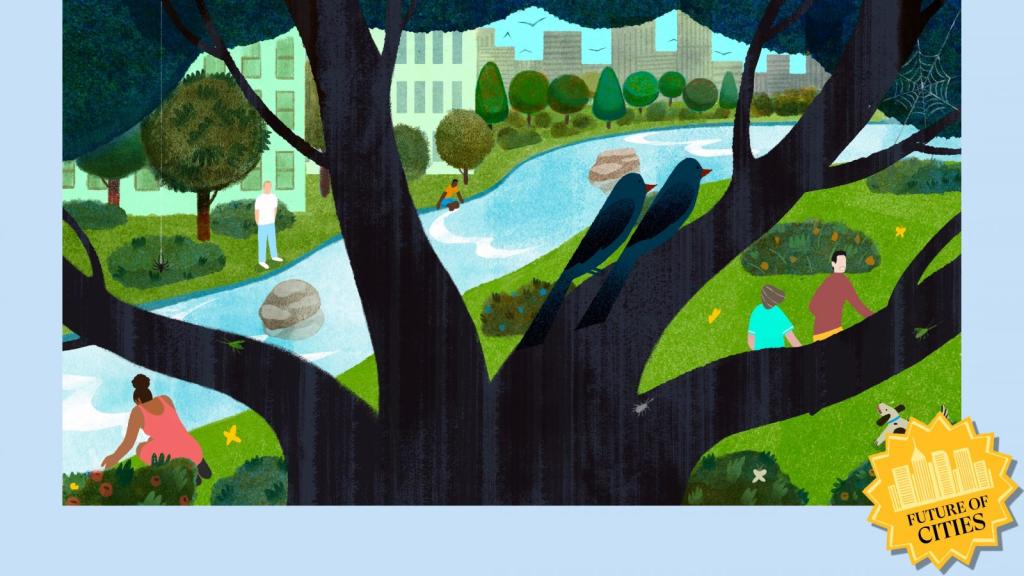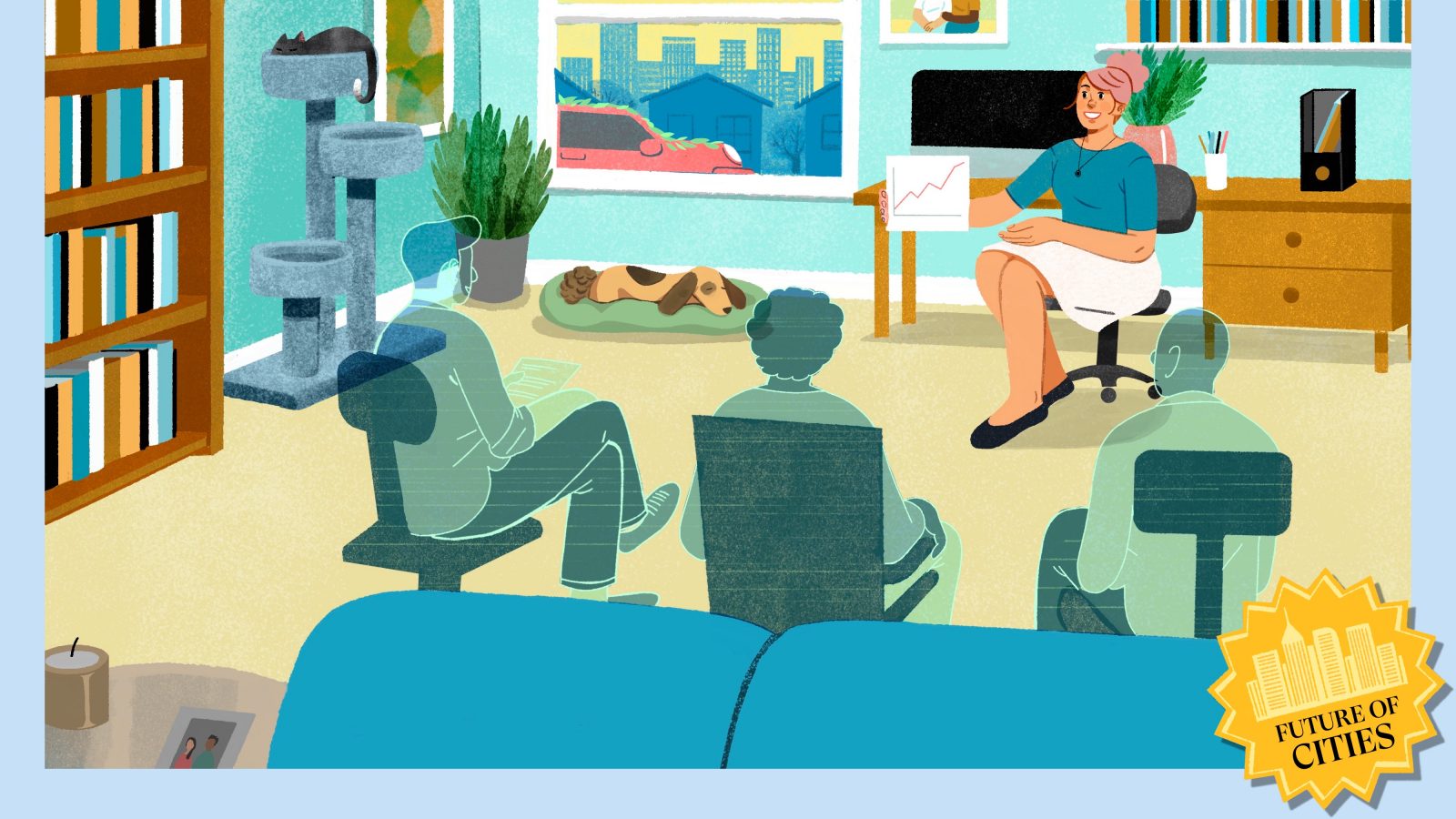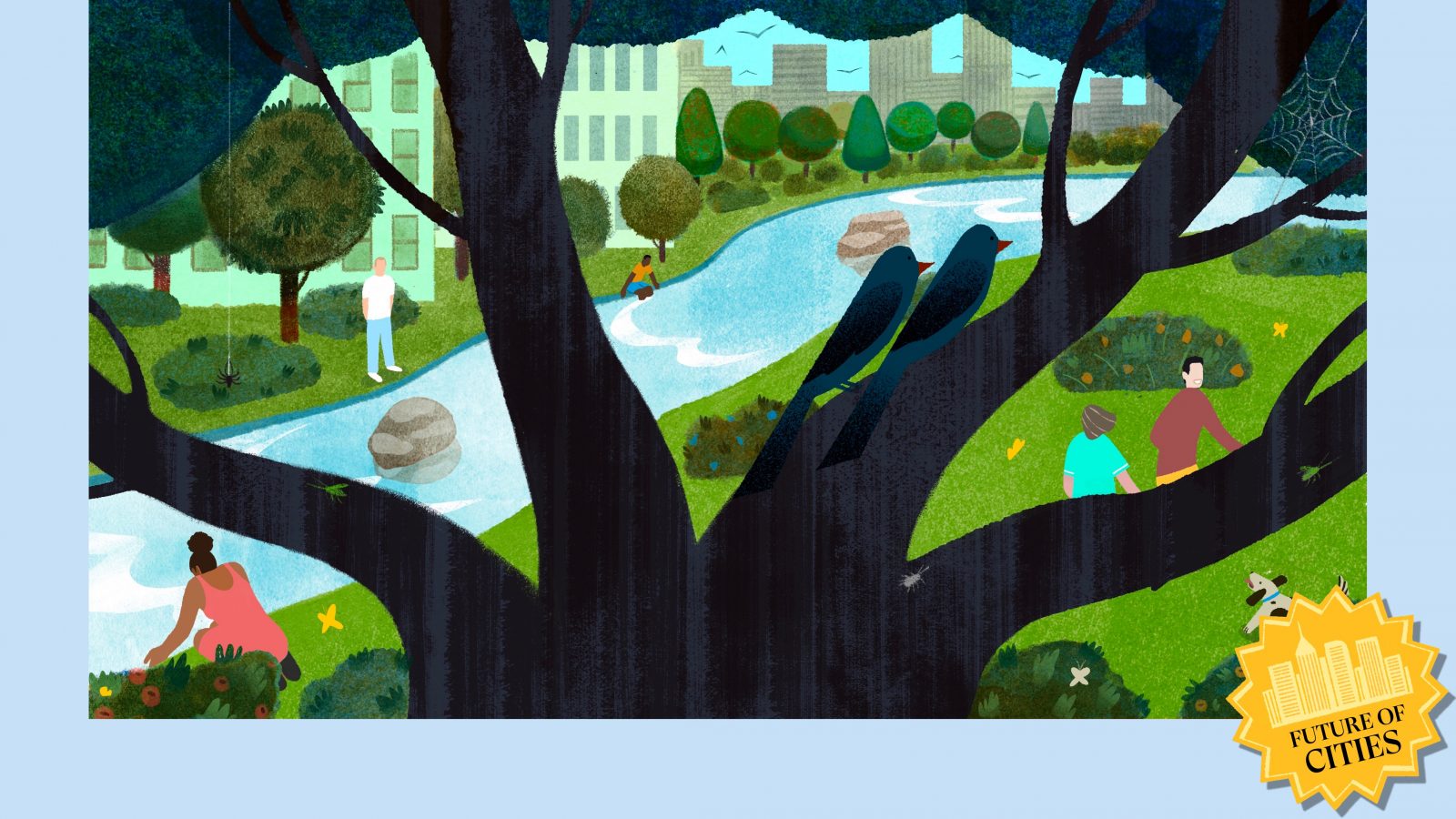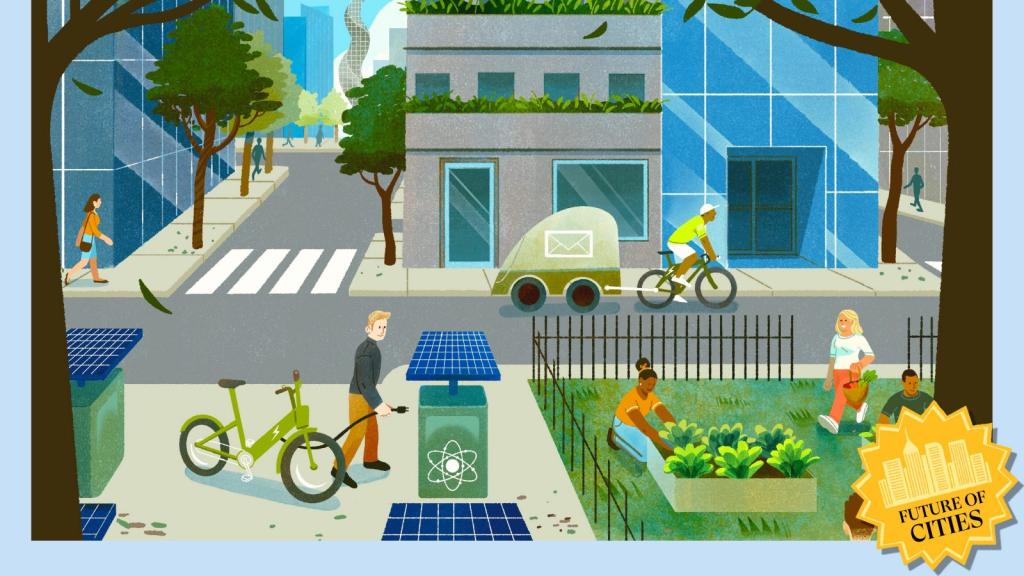As the climate changes, cities must change with it. Fix is exploring how our urban centers are being reimagined and what green, equitable, and resilient communities could look like. With insights from local officials, architects, residents, and more, our Sustainable Cities of the Future series examines how we’ll live, work, and play in the cities of tomorrow. (Explore the full series so far.)
Before the COVID-19 pandemic sent the entire country into lockdown, just 17 percent of Americans regularly worked from home. That number nearly tripled as social distancing shut down offices and other facilities the world over. Today, around 44 percent of U.S. workers are on the couch, at the dining room table, or if they’re lucky, in a beautifully appointed home office with dual monitors and a sweet headset. And many people don’t want to go back.
The virtues of remote work make a lengthy list. It offers greater flexibility, increased productivity, and more freedom to get things done outside of work. It leads to improved access for people with disabilities or other needs that prevent them from traveling every day. And, of course, it kills the commute — which helps the planet in a big way, considering that the transportation sector is the largest contributor to greenhouse gas emissions in the U.S.
“Working from home saves energy, even when you’re factoring in things like computer and cloud infrastructure,” says Jeremy Bailenson, a professor of communication and the founding director of the Virtual Human Interaction Lab at Stanford University. By one estimate, a videoconference may use just 7 percent of the energy required for an in-person meeting. Although “Zoom fatigue” quickly became a widespread phenomenon during quarantine, Bailenson and his team are testing tech that could make virtual conversations feel as natural as the real thing. He believes the next generation of Zoomlike tools will enable more and more people to work — and live — wherever they want.
Even as offices reopen, our cities — especially our business districts — are not likely to look the same. (Imagine L.A. with half the cars on the road, or New York with far fewer people on the subway.) Only one in 10 companies expect to bring everyone back to an in-person workspace under business as usual. With fewer office days, and fewer people around each day, maintaining workplaces the way we used to will become difficult to justify financially. That could mean commercial buildings, even entire zip codes, are in for some reimagining. Spaces that previously housed one company or organization could become multiuse. Time spent together in person — and even rarer, time spent with full staffs together — may be valued differently, putting an end to cubicles and favoring room setups that maximize collaboration and cross-pollination. Some workplaces may be abandoned entirely and turned into housing, while smaller satellites pop up in more residential areas.
Bailenson, who has spent more than two decades studying how communication technology changes the ways we live and work, shared some of his predictions for the future of the virtual office and the still-unrealized potential of VR. His responses have been edited for length and clarity.
Q. There’s such a newfound focus on virtual communication and work. What does that say about the future of the commute?
A. I’ve been working on remote communication for 20 years. I have a colleague at Samsung, Dirk Smits, who used to say, “If we do our jobs right, the suburbs are going to disappear” — because no one’s going to need to live on the edge of a big city anymore. You get to live wherever you want. We’re starting to see that in San Francisco. There was a big piece in the New York Times about tech workers fleeing the Bay Area for a variety of reasons and moving to other cities.
There’s going to be a big role for augmented and virtual reality now that their stigma has been broken. We are past everybody driving to work for an hour each way every day to sit in a cubicle and pound on a computer. That’s done. And the hope is that buying a car becomes much more of a decision -— yea or nay — than it is now.
Help us imagine the sustainable cities of the future. We want to hear what you’re seeing today that’s exciting, or your biggest ideas for the future.
Q. After the pandemic, do you think teleworking will persist in such a major way?
A. Like most things in life, it’s going to be somewhere in the middle. We all want to see people, when it’s fun. But if you think about most people’s jobs in the knowledge-working category, a lot of it is staring at a screen. Obviously workplaces like factories and the service industry are in a different bucket.
I think we will still go to a physical office. The notion that you have to be there at 9 and you have to leave at 5, five days a week, I believe is one of the past. We have broken that bubble, and I don’t think there’s any going back.
Q. What will that mean for offices and business districts?
A. One of the ways we often see disruption is by sharing stuff — sharing your home through Airbnb, sharing your car through all sorts of apps. The office is a place that doesn’t get used for 16 hours a day. And think about the amount of materials that go into building these big office parks and keeping them functioning when no one’s there, which, under normal circumstances, is already two-thirds of the time for most places. Think about the amount of energy you could save just on this infrastructure.
You can compare it to a seat on a train. It is yours for a few hours, you are very comfortable using it “on demand,” and then it belongs to someone else a few hours later. Offices should follow the same concept.
Q. How can virtual communication continue to improve?
A. With Zoom in particular, I would like to see them make “hide self view” the default — that’s an easy, low-hanging fruit that will ease the self-evaluation we do while looking at ourselves in that mirror all day. There should also be an ability to set a maximum face size. With the current default setting for a one-on-one call on Zoom, the closeness you experience with a coworker is equal to the comfortable standing range between spouses. Computer vision allows Zoom to know the distance between your eyes and the screen — that’s how the “hide background” function works — so it could set a max face size based on your configuration. This would avoid that kind of overflow of intimacy.
A third one, a home run, would be to do some of what Microsoft Together mode has done in making eye-gaze diagnostic — so when you’re looking at somebody in the grid, they’ll have some sense of that.
There has been an energy behind remote work in the startup space, the VC space, and in bigger companies shifting their priorities. What’s got me most excited are companies that are beginning to look at what Zoom did not get right, and saying, “Let’s sprint and figure out the way to make a new platform around it.” There’s just a ton of energy in that space.
[Read more about how Bailenson uses VR to convince climate change skeptics on the 2018 Grist 50 list]
Q. What about the next frontier: VR?
A. What I’ve long lobbied for in my day job as a virtual reality researcher is using VR to simulate all the face-to-face aspects of meetings. One of the big projects we’re working on right now is building and testing augmented reality simulations where you’re “beaming” a person into your space — and that person is there. All the nonverbal cues, like eye gaze, work correctly. Virtual communication can allow us to really be with other people in a way that uses the evolutionary mechanisms of how we interact.
Q. Wild. What about other, nonwork experiences? Has the pandemic created the appetite for VR to really, finally take off?
A. People do have an intense hunger for good virtual experiences right now. In my house, I probably have 20 pairs of goggles of different shapes and sizes. I spend about an hour or two a week in VR. Most of that’s job related, although I do really like this workout program called Supernatural. But in general, VR is not an everyday thing.
I’ve also got a 9- and 6-year-old. When COVID first hit, I thought, “I’m a leg above a lot of people. I’ve got all these goggles and I’m just going to find all this great educational content, and my kids will get to do VR, too!” I was sorely mistaken about the amount and the availability of content that’s good for kids and good for learning. In the pandemic, there was a huge uptick in VR use initially among families with kids. People tried it, even kept it going for a week or two, and then kind of put it down.
We need more good content designed for VR. When VR adds value, to the point where it’s really worth putting those goggles on your head and being shut out from the world, then people are going to use it.
Explore more in our series on Sustainable Cities of the Future:
>> These 5 people are building the green cities of the future
>> An AI plots to take over a community’s solar power in this short story
>> What big cities can learn about climate adaptation from rural Louisiana
>> Opinion: Biden’s big conservation plan must include cities
>> What big ideas do you have for the future of cities? Share your thoughts here




